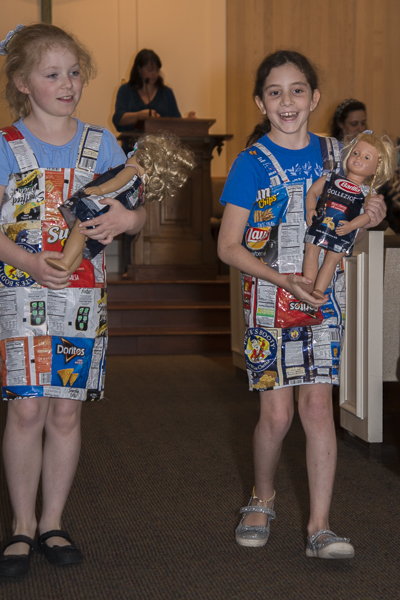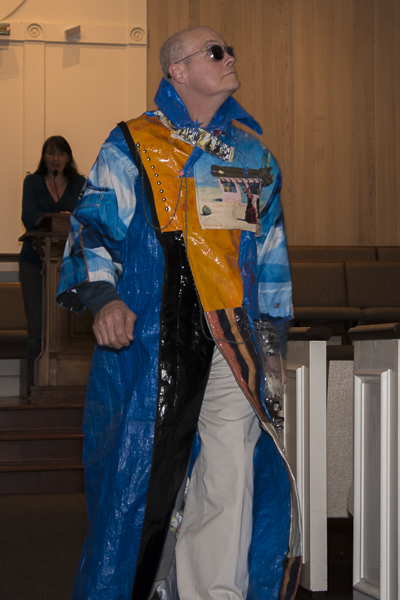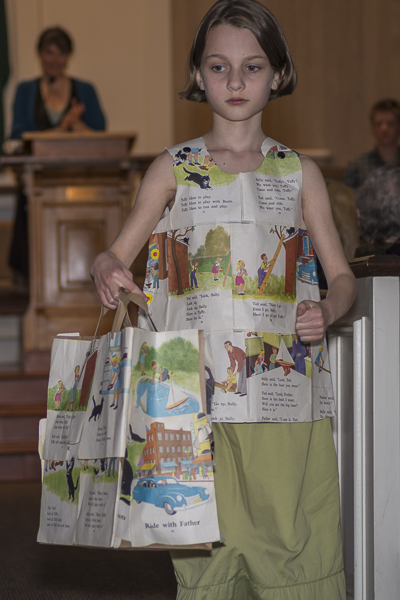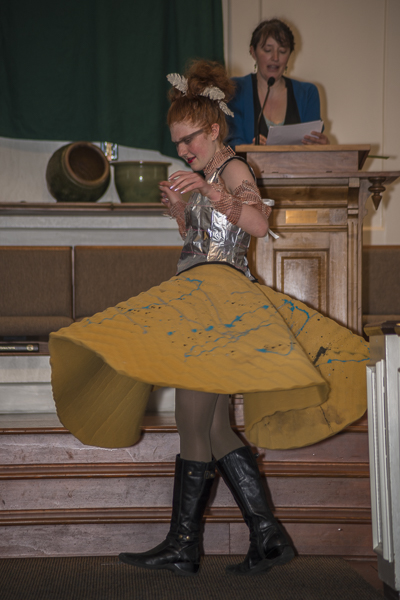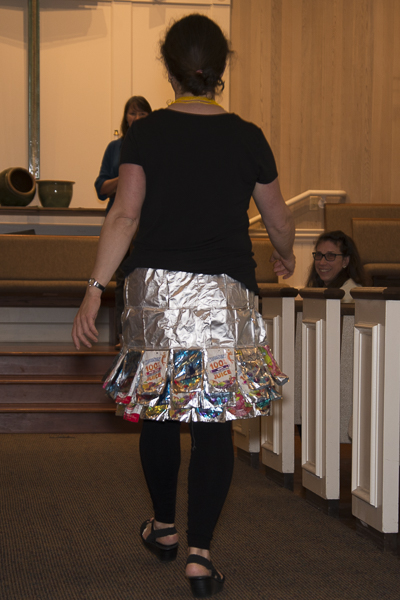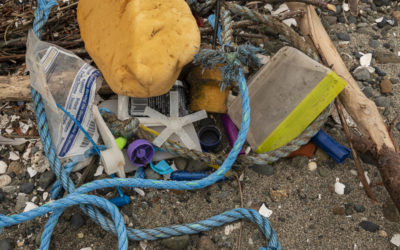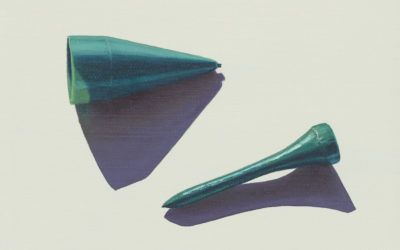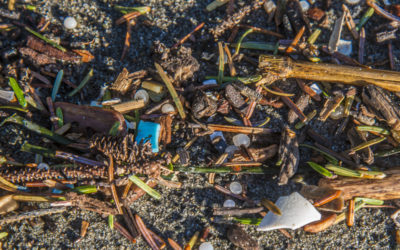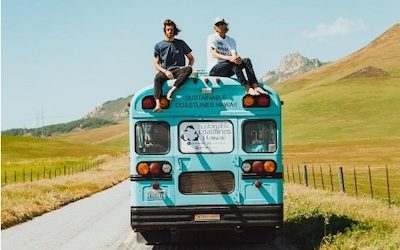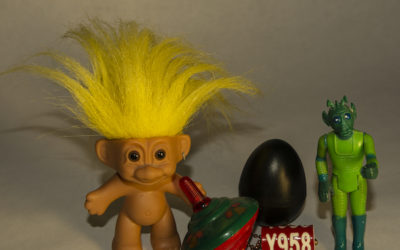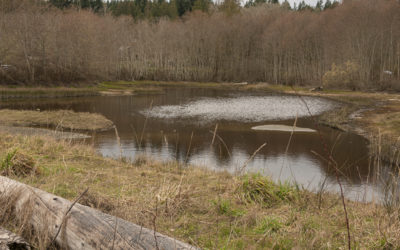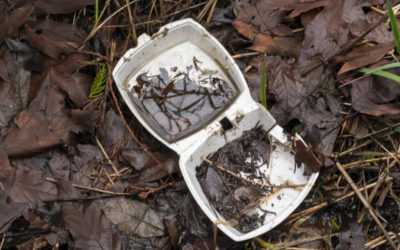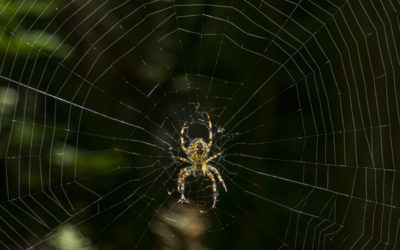PRÊT-À-PORTER PLASTICS
by Deb Rudnick, Spring 2020
Photos by John F. Williams except as noted
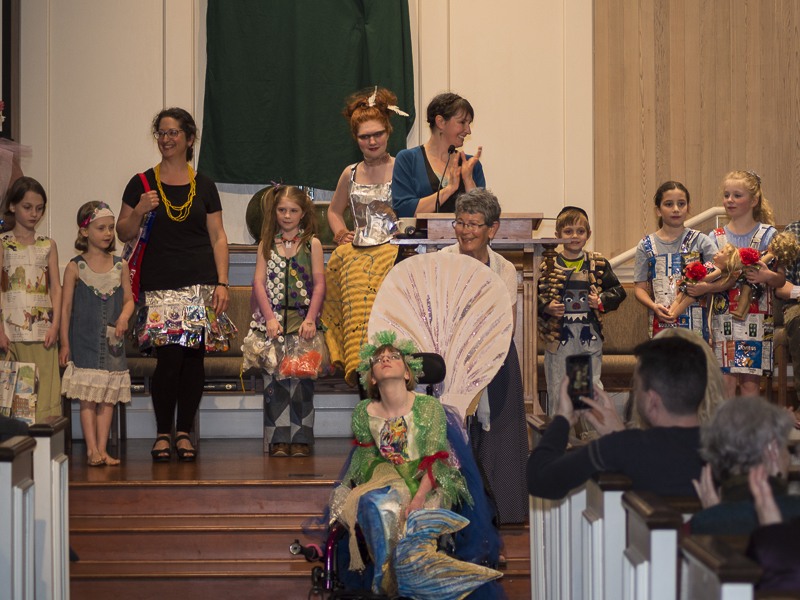
PRÊT-À-PORTER PLASTICS
by Deb Rudnick, Spring 2020
Photos by John F. Williams except as noted
A bubble wrap bridal gown.
Patio umbrella fabric cargo pants.
A dress of VHS tape and electric cords.
A grocery bag tutu.
Plastic clothes???
Yes, these incredible items have all been on display at the annual Bainbridge Island Trashion Show.
Started in 2016 by fabric artist Naomi Spinak and members of Sustainable Bainbridge, the Trashion Show calls on artists in the community to marry their sewing skills to a sense of (re)purpose to create wearable art from upcycled, recycled, and repurposed materials.
The Bainbridge Trashion Show was born out of the recognition of the incredible impacts of the fashion industry. About one out of every six people on the planet are involved in the fashion industry in some way, including growing the materials, creating the fabric, sewing or selling the clothes — but fewer than 5% earn a living wage. And the environmental impacts of this industry are absolutely enormous in terms of its use of energy, water, and materials.
About 60% of clothing today is made is created from plastics, which can be energy and water intensive to produce, and creates a unique problem when plastic microfibers are shed from these clothes and end up in our waterways, as Julie Masura shows us in her article on studying plastics in Puget Sound.
 See more about microfibers and the study of plastics in our environment in Julie’s Microplastics article in Issue #7.
See more about microfibers and the study of plastics in our environment in Julie’s Microplastics article in Issue #7.
The Trashion Show’s goals are to raise awareness about these serious impacts, and to highlight ways we can respond to these problems. We want to get our audience thinking about how we can all work to shrink the environmental impacts of our clothes. The Trashion Show helps with this by highlighting repurposing and reuse, mending and repair, and better purchasing and stewardship of the clothing we do own. And, we can make incredibly creative and fun clothing along the way!
Bainbridge Island is hardly the first community to host a trashion show — over the past several years, fashion shows that bring issues of sustainability and reuse to the forefront have blossomed around the country and the globe. It’s a great sign that we are increasingly aware that the fashion industry can reduce its environmental footprint while still creating inspirational, and enjoyable clothing.
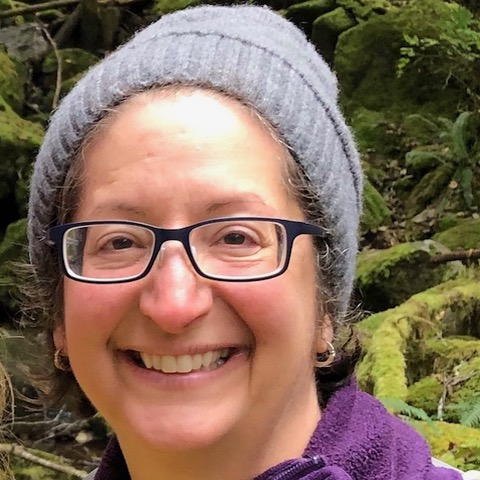
Deb Rudnick, Ph.D., is an ecologist who is passionate about observing and stewarding the environment of Puget Sound. Deb received her doctorate in Environmental Science, Policy and Management from the University of California, Berkeley. Deb grew up connected to the fields, woods, marshes and meadows of New England, and slowly migrated westward, with stops in Colorado and California before setting down roots on Bainbridge Island. Deb has worked for federal, county and local governments, private industry, and has taught students from kindergarden to college. She is currently the K-5 Science Coordinator for the Bainbridge Island School District and the Chair of the Bainbridge Island Watershed Council, a program of Sustainable Bainbridge. She serves on the West Sound Program for Ecosystem Recovery’s Technical Advisory Committee, and on the City of Bainbridge Island’s Climate Change Advisory Committee. Deb loves to knit, birdwatch, cycle, garden and hang out with her family and their menagerie of dog, gerbil, and chickens.
Table of Contents, Issue #7, Spring 2020
Plastics & Our Salish Sea
by Alison Ahlgrim, Spring 2020Photo by John F. WilliamsPhoto by John F. Williamsby Alison Ahlgrim, Spring 2020 Take a walk along a beach anywhere along the Salish Sea, and you are likely to see all kinds of plastic waste – bottle caps, bags, toys, Styrofoam, bottles,...
Art and Plastics
by Karen Hackenberg, Spring 2020Painting by Karen HackenbergPainting by Karen Hackenbergby Karen Hackenberg, Spring 2020 Between Scylla and Charybdis, oil on linen, 28"x35", 2019, by Karen Hackenberg.My painting Between Scylla and Charybdis, can be seen as a metaphor...
Microplastics
by Julie Masura, Spring 2020Photo by Julie MasuraPhoto by Julie Masuraby Julie Masura, Spring 2020 “What do you know about plastics?" "Absolutely nothing.” This was the beginning of microplastics research at the University of Washington Tacoma’s Center for Urban...
Schroadtrip
"SCHROADTRIP": A PARLEY FOR THE OCEANS INITIATIVEby Nick Schippers (with Hans Schippers), Spring 2020 Growing up surfing on Washington’s remote and rugged coastlines, my brothers and I learned early on just how important our waters are. As avid surfers and watermen,...
Poetry-7
Poetry Spring 2020A Plastic Future Is Not Fantastic by Mahathi Mangipudi Photo by John F. WilliamsSmall Things by Janet Knox We gift them tiny plastic things to sit on a shelf or play and break to signify like or caring or thinking of you then toss in landfills...
Kingdom of Plastics
by Julie Jeanell Leung, Spring 2020Photo of Schel Chelb estuary by John F. WilliamsPhoto of Schel Chelb estuary by John F. Williamsby Julie Jeanell Leung, Spring 2020 Standing on the beach at the Schel Chelb Estuary, three days after the winter solstice in 2012, I...
Addressing the Plastic Problem
by Heather Trim, Spring 2020Photo by John F. WilliamsPhoto by John F. Williamsby Heather Trim, Spring 2020 Plastic waste is an issue for Washingtonians because we are a coastal state, and we have remaining endangered species who are potentially being impacted by...
A New Hope for Plastics
by Adelia Ritchie, Spring 2020Photo by John F. WilliamsPhoto by John F, Williamsby Adelia Ritchie, Spring 2020 If you’ve ever had to clear out those pesky cobwebs from every corner of your house, you know how ubiquitous and stubbornly persistent our house spiders can...
PLEASE HELP SUPPORT
SALISH MAGAZINE
DONATE
Salish Magazine contains no advertising and is free. Your donation is one big way you can help us inspire people with stories about things that they can see outdoors in our Salish Sea region.
We also don't advertise Salish Magazine, so please spread the word of this online resource to your friends and colleagues.
Thanks so much for your interest and your support.
We also don't advertise Salish Magazine, so please spread the word of this online resource to your friends and colleagues.
Thanks so much for your interest and your support.

